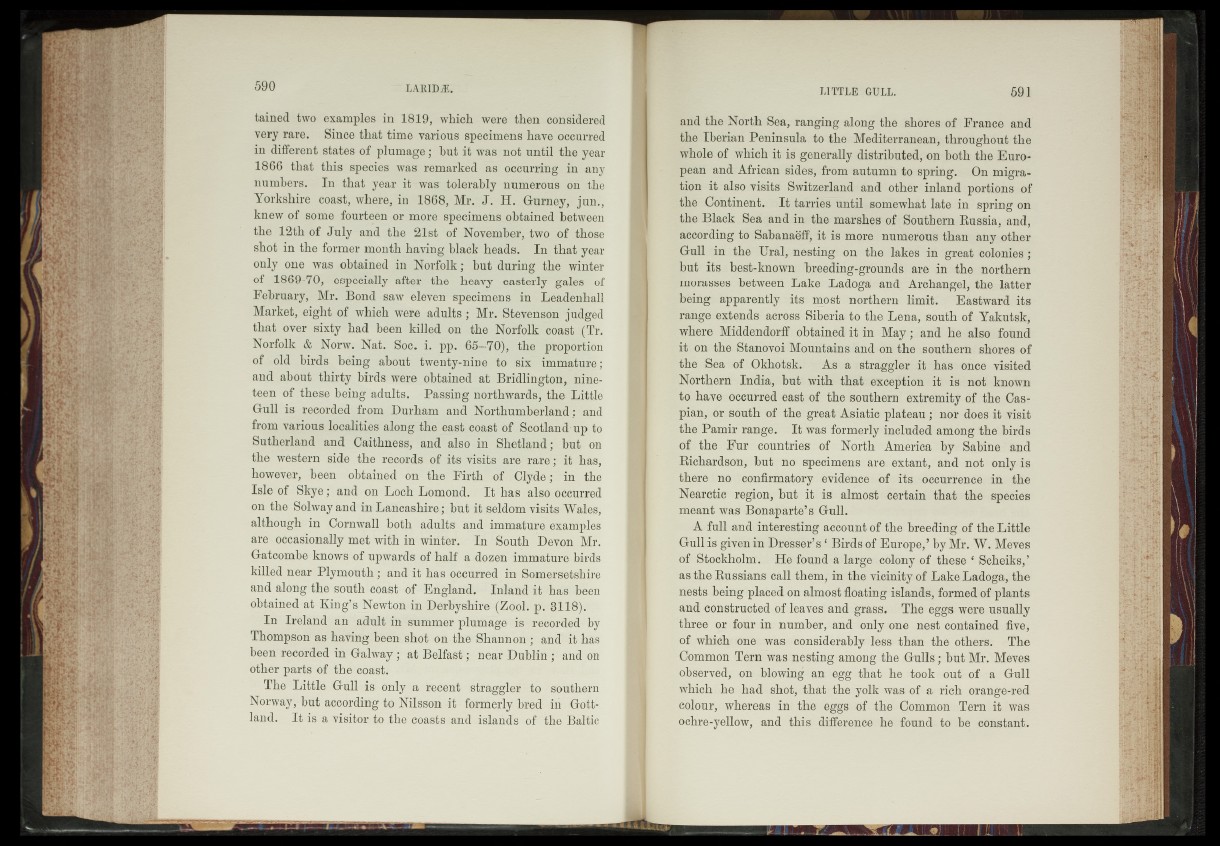
tained two examples in 1819, which were then considered
very rare. Since that time various specimens have occurred
in different states of plumage; but it was not until the year
1866 that this species was remarked as occurring in any
numbers. In that year it was tolerably numerous on the
Yorkshire coast, where, in 1868, Mr. J. H. Gurney, jun.,
knew of some fourteen or more specimens_obtained between
the 12th of July and the 21st of November, two of those
shot in the former month having black heads. In that year
only one was obtained in Norfolk; hut during the winter
of 1869-70, especially after the heavy easterly gales |of
February, Mr. Bond saw eleven specimens in Leadenhall
Market, eight of which were adults; Mr. Stevenson judged
that over sixty had been killed on the Norfolk '^oas-t <Tr.
Norfolk & Norw. Nat. Soc. i. pp. 65-70), the -proportion
of old birds being about twenty-nine to six immature;
and about thirty birds were obtained at Bridlington,-raine-
teen of these being adults. Passing northwards, the Little
Gull is recorded from Durham and-Northumberland ; and
from various localities along the east,coast of Scotland ■ up |b
Sutherland and Caithness, and also in Shetland; but on
the western side the records of its visits are rare; it has,
however, been obtained on the Firth of 'Clyde ;• in the
Isle of Skye; and on Loch Lomond. It has also occurred
on the Solway and in Lancashire; but itseldom visitsrWales,
although in Cornwall both adults and immature exariiples
are occasionally met With in winter. In '“South Devon Mr.
Gatcombe knows of upwards of half a-dozen immature bards
killed near Plymouth; and it has .occurred in Somersetshire
and along-the south coast of England5. Inland it ha:s heen
obtained at King’s Newton^in Derbyshire :(*Zool. p. 3118);
In Ireland an adult in sfemmer plumage' is -rOcOr-ded- by
Thompson as having-been shot on the Shannon ; and it has
been recorded in Galway; at Belfast*;« near Dublin ; and oh
other parts of the coadt* |
The Little Gull is only a recent atraggler Sfl southern
Norway, but according to Nilsson "If; formerly'bred
land. Itris a visitor to the coasts and islands of the Baltic
and the North Sea, ranging along the shores of France and
the Iberian Peninsula to the Mediterranean, throughout the
whole of which it is generally distributed, on bath the European
and Africans sides, from autumn to spring. On migration
it also visits Switzerland and other inland portions of
the Continent.,' It tarries^until somewhat late in spring on
the Black Sea and in- the marshes of Southern Russia, and,
according to Sabanaeff, it is more numerous than any other
Gull in the Ural, nesting on the lakes in great colonies;
but-its best-known breeding-grounds are in the northern
morasses between Lake Ladoga and Archangel, the latter
being apparently its most northern limit. Eastward its
range extends-across Siberia to the Lena, south of Yakutsk;
where Middendorff obtained it in May; and he also found
it bm the Stanovoi-Mountains and on the southern shores of
the Sea of Okhotsk» As a straggler it has Once visited-
Northern India, but with that exception it is not known
to have - occurred east of the southern extremity of the Caspian,
Or south of the great Asiatic plateau; nor does it visit
the Pamir range. It was formerl^included among the birds
of the Fur countries' of North America by Sabine and
Richardson, but no specimens are. extant, and not only is
there no confirmatory evidence, of . its -occurrence in the
Nearctic region, but it is almost certain that the species
meant was Bonaparte’s Gull.
A full and- interesting account of the breeding of the Little
Gull is given in-Dresser’s \ Birds of Europe,’ by Mr. W. Meves
of Stockholm. He found a larger colony of these 3 Scheiks,’
as the Russians call them, in the vicinity of Lake Ladoga, the
nests being placed on almost floating islands, formed of plants
and constructed of leaves and grass. The eggs were usually
'three or four in number, and -only one nest contained five,
©f- which-one was considerably less than the others.- -The
Common Tern was nesting among the Gulls; but Mr. Meves
observed', on blowing an egg that he took ->dmtrof a Gull
which he had shot, that ■ the-yolk was of a rich orange-red
Hcdour, whereas in- the eggs.,-of - the Common Tern it was
ochre-yellow, and this difference he found to/be constant.